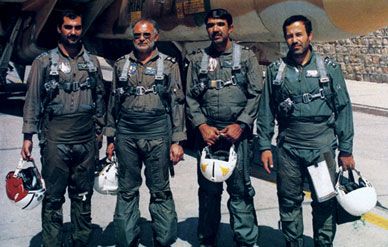Originally Posted By: Win
Are the seats adjustable? If not, how is the cockpit fitted to the aircrew? Do the stick and rudder pedals adjust to the crewmember, or is it a one size fits all?
Is it a dual control aircraft capable of being flown from either crew position?
How do you keep your feet on the rudder pedals in a high G maneuver? Are there stirrups or something to keep them firmly located? Are the rudder pedals just rudder pedals, or do they have toe brakes or other control functions? Do you work the rudder pedals, or do the flight computers take care of that?
How long can the aircrew handle being in the aircraft, before their reliability breaks down? I imagine with all the noise, no room to stretch, concentration, etc., it saps you pretty fast.
Did you ever get a few minutes to just enjoy flying the big plane, or was it all work, all the time?
Hey Win - in order...
The seats adjust vertically for different heights. It's an ejection seat, so you can't adjust much without messing up the ejection geometry. The rudder pedals adjust for reach, so the airplane accomodates a wide range of sizes...
There is only one set of controls. Makes for an interesting first flight. First flight in the jet, for a pilot, is with an instructor pilot in the back seat. In the back seat, that instructor has two controls: intercom switch and ejection seat. The latter to be used if the former is ineffective....
That instructor pilot was the same instructor that gave the new pilot his simulator checkride. The simulator syllabus was rigorous and extensive.
The pedals are conventional airplane pedals, with toe brakes at the top...under G, your heels ride on slick, stainless steel floor tracks, so you can easily slide your feet back and forth.
The Tomcat's flight controls, when I flew it, were mechanical with computer stability agumentation. In the hands of a great pilot, it was a truly formidable fighter, able to maneuver at very low speed and very high AOA...but because it was mechanical, the pilot's skill really, really mattered. Anyone could fly the Hornet at high AOA, it was built for it and easy to handle, but the Tomcat demanded a skilled driver to perform to its best.
Even on missions, there were lots of times to enjoy the airplane. You had to stay focused, you to stay engaged, but once in a while, you could look around and enjoy the view...or have fun on the way to your assigned station...
My longest mission was a bit over 7 hours, during Desert Storm. This required multiple in flight refuelings. I was dragging at the end of it. Since you're strapped tight into an ejection seat, there isn't much wiggling around, or changing position, although I personally would mash the G-suit inflation button pretty often and "massage" my legs and lower abdomen to keep the blood flowing...
The g-suit was part of the long list of gear I mentioned above...it was precisely fitted to each pilot/RIO. Like a pair of high pants, it came up to just under your ribcage, with openings around your hips and knees. It was pressurized proportional to g-force on the plane, and inflated to pressurize your lower legs, thighs, and lower abdomen. That inflation forced the blood back up into your torso during high-G maneuvers and allowed your heart to continue providing blood to your brain. Described here:

en.wikipedia.org
We trained in a centrifuge at up to 9 G...it takes a lot more effort than people realize to remain conscious at that G-level...google Centrifuge Training, and watch some of the videos...of guys and gals not being able to maintain the blood pressure necessary...
I loved pulling G...could do it all day, up to about 6G. It took a combination of muscle strength (we lifted weights) and aerobic capacity (we ran) to be able to raise your thoracic/blood pressure to keep the flow to your brain. Tall (like me) and low resting pressure (again like me) worked against you. The workouts and the experience in the plane made it easier...but at about 7.5G, for me, the capillaries in the back of my thighs would start to burst, I would feel tingling, and I knew that I was at the F/A-18s stress limit, or about 1.0 G over the Tomcat's stress limit...and there would be little blood spots, we called them "G-measles", on the back of my legs..



